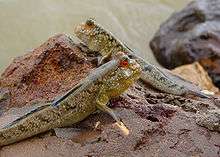Atlantic mudskipper
The Atlantic mudskipper (Periophthalmus barbarus) is a species of mudskipper native to fresh, marine and brackish waters of the tropical Atlantic coasts of Africa, including most offshore islands, through the Indian Ocean and into the western Pacific Ocean to Guam.[2] This species occurs on the tidal flats of mangrove forests where it readily crosses mud and sand surfaces out of the water, using its pectoral fins to move.
| Atlantic mudskipper | |
|---|---|
 | |
| Periophthalmus barbatus from Gambia | |
| Scientific classification | |
| Kingdom: | Animalia |
| Phylum: | Chordata |
| Class: | Actinopterygii |
| Order: | Gobiiformes |
| Family: | Oxudercidae |
| Genus: | Periophthalmus |
| Species: | P. barbarus |
| Binomial name | |
| Periophthalmus barbarus (Linnaeus, 1766) | |
| Synonyms | |
| |
Distribution
Periophthalmus barbarus is found throughout West Africa, in mangrove swamps and primarily brackish bodies of water near the coast.[1] Countries where the mudskipper are found include Angola, the Democratic Republic of the Congo and Cameroon.[1]
Usage by humans
It is important to local indigenous peoples as a food fish and can also be found in the aquarium trade.[1] Fishing has caused population declines in parts of the species' range.[3]
Diet
Periophthalmus barbarus is an omnivore.[4] In the wild, mudskippers prefer to eat worms, crickets, flies, meal worms, beetles, small fish, and small crustaceans (sesarmid crabs).[4] Mudskippers kept as pets can eat frozen fare such as bloodworm or artemia and flake. It cannot eat dried food, however, because its stomach would swell up. It is recommended to feed it frozen food for a healthy diet.[5]
Characteristics
Periophthalmus barbarus and mudskippers generally are able to tolerate high concentrations of toxic substances produced by industrial waste, including cyanide, in their environments.[2] They are also able to survive in a variety of environments, including waters with different temperatures and salinity levels.[2]
References
- Bousso, T.; Lalèyè, P. & Moelants, T. (2010). "Periophthalmus barbarus". The IUCN Red List of Threatened Species. 2010: e.T182285A7850201. doi:10.2305/IUCN.UK.2010-3.RLTS.T182285A7850201.en.
- Emuebie, Okonji Raphael (2011). "Physicochemical Properties of Mudskipper ( Periophthalmus Barbarus Pallas) Liver Rhodanese". Australian Journal of Basic and Applied Sciences. 5 (8): 507–514.
- Etim, Lawrence (June 2002). "Breeding, growth, mortality and yield of the mudskipper Periophthalmus barbarus (Linnaeus 1766) (Teleostei: Gobiidae) in the Imo River estuary, Nigeria". Fisheries Research. 56 (3): 227–238. doi:10.1016/s0165-7836(01)00327-7.
- "Periophthalmus barbarus". Mudskipper.it. Retrieved 28 October 2016.
- Froese, Rainer and Pauly, Daniel, eds. (2013). "Periophthalmus barbarus" in FishBase. June 2013 version.
| Wikimedia Commons has media related to Periophthalmus barbarus. |
